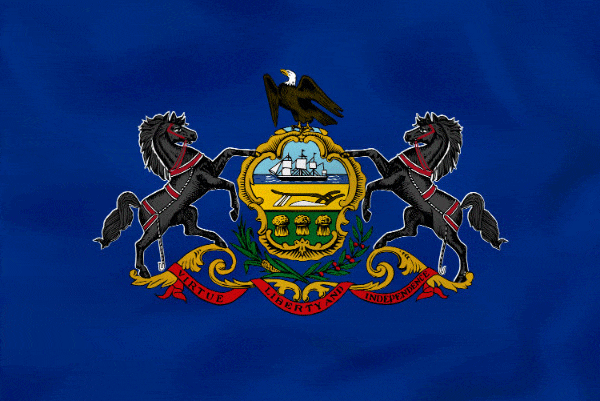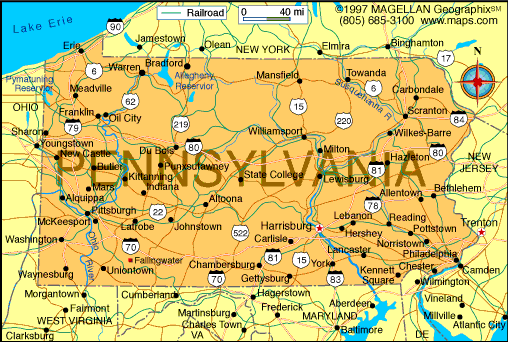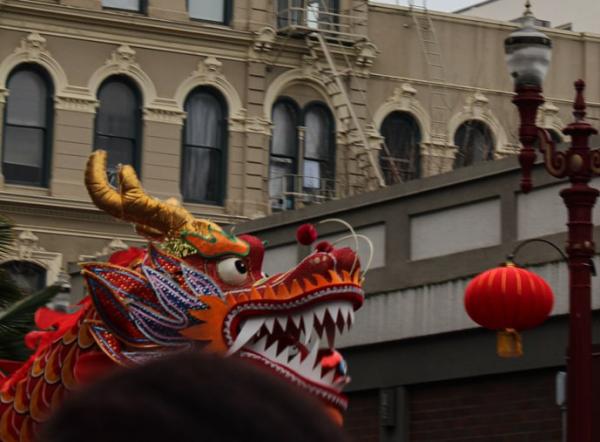Pennsylvania


Pennsylvania State Information
Official Name: Commonwealth of Pennsylvania
Capital: Harrisburg
Organized as a territory: 1681
Entered Union (rank): December 12, 1787 (2nd)
Present constitution adopted: 1968
State abbreviation/Postal code: PA
Nickname: Keystone State
Origin of name: In honor of Adm. Sir William Penn, father of William Penn. It means “Penn's Woodland.”
Motto: “Virtue, liberty, and independence”
Slogan: "Pennsylvania. Pursue Your Happiness"
State symbols:
Flower: Mountain laurel (1933)
Tree: Hemlock (1931)
Bird: Ruffed grouse (1931)
Dog: Great Dane (1965)
Colors: Blue and gold (1907)
Song: “Pennsylvania” (1990)
Government
Governor: Tom Wolf (to Jan. 2023)
Lieut. Governor: Kim Ward (to Jan. 2023)
Secy. of State: Leigh M. Chapman (to Jan. 2023)
General Treasurer: Stacy Garrity (to Jan. 2023)
Atty. General: Josh Shapiro (to Jan. 2023)
U.S. Representatives: 203
Senators: Bob Casey Jr, D (to Jan. 2023); John Fetterman, D (to Jan. 2023)
Population
Residents: Pennsylvanian
Resident population: 12,964,056(5th Largest State, 2021)
10 largest cities (2021): Philadelphia, (1,596,865); Pittsburgh, (303,207); Allentown, (125,250); Erie, (95,536); Reading City, (94,161); Upper Darby, (84,986); Scranton, (75,987); Lower Merion, (63,064); Bensalem, (62,456); Abington, (58,131)
Race/Ethnicity: White (76.6%); Black (11.8%); Hispanic/Latino (8.1%); Asian (4.5%); Native American (1.1%), Pacific Islander (0.1%); Other (1.3%)
Religion: Protestant (47%); Catholic (24%); Jewish (1%); Muslim (1%), Hindu (1%), Other (2%)
Sex: Male (48.9%); Female (51.1%).
Age: Under 5 (5.3%); Under 18 (20.6%); 18-64 (55.1%); 65 and over (19%). Median Age: 40.6 years
Economy
GDP: 839.4 billion dollars (6th in U.S., 2021)
Unemployment: 4% (2022)
Geography
Land area: 46,055 sq mi (119,283 km2)
Geographic center: In Centre Co., 21/2 mi. SW of Bellefonte
Number of counties: 67
Largest county by population and area: Philadelphia, 1,627,134 (2021); Lycoming, 1,235 sq mi.
State parks/recreation areas: 116
Pennsylvania holds an important place in the story of the United States. One of the original 13 colonies and with both the Declaration of Independence and U.S. Constitution having been signed in Philadelphia. The state has a rich industrial heritage with the region’s coal and iron resources helping to fuel the country's growth.
It has provided the foundations for a strong modern-day economy which has grown and diversified to become the sixth largest GDP in the U.S. In recent years, the state has become an important center for healthcare, education, and tourism with millions of visitors attracted to the state’s historical sites.
Rich in historic lore, Pennsylvania territory was disputed in the early 1600s among the Dutch, the Swedes, and the English. England acquired the region in 1664 with the capture of New York, and in 1681 Pennsylvania was granted to William Penn, a Quaker, by King Charles II.
Philadelphia was the seat of the federal government almost continuously from 1776 to 1800; there the Declaration of Independence was signed in 1776 and the U.S. Constitution was drawn up in 1787. Revolutionary War fame, and Gettysburg, site of the pivotal battle of the Civil War, are both in Pennsylvania. The Liberty Bell is located in a glass pavilion across from Independence Hall in Philadelphia.
The nation's first oil well was dug at Titusville in 1859, and the mining of iron ore and coal led to the development of the state's steel industry. More recently Pennsylvania's industry has diversified, although the state still leads the country in the production of specialty steel. The service, retail trade, and manufacturing sectors provide the most jobs; Pennsylvania is a leader in the production of chemicals and pharmaceuticals, food products, and electronic equipment.
Pennsylvania State Geography
Pennsylvania is a state located in the northeastern and Mid-Atlantic regions of the United States. It is the 33rd largest state in terms of area but the fifth most populous. The state is bordered by New York to the north, New Jersey to the east, Delaware to the southeast, Maryland to the south, and West Virginia to the southwest.
Pennsylvania has a diverse mix of geography which ranges from marine estuaries to mountainous plateaus. The northern and central areas of the state are dominated by the Appalachian Mountains.
The Appalachian mountain range runs through the state from the southeast to the northwest, with the highest point being Mount Davis, with an elevation of 3,213 feet (979 m). Pennsylvania also has several low-lying areas, including the Delaware River Valley, which separates the Appalachians from the Poconos, and the Great Appalachian Valley, which runs through the center of the state.
The climate of Pennsylvania is generally classified as being a humid continental climate, with cold winters and warm summers. The state experiences four distinct seasons, with temperatures that vary widely depending on location and altitude. The average January temperature is around 30°F (-1°C) and summer temperatures are around 74°F (23°C).
The state experiences a significant amount of precipitation, with an average of about 44 inches (112 cm) per year. Extreme weather types that are common include flooding, thunderstorms, and occasional tornadoes.
Notable natural features in Pennsylvania include the Delaware Water Gap, which is a scenic pass through the Appalachian Mountains, and the Allegheny National Forest which is a large wooded area located in the northwest part of the state.
Pennsylvania is also home to several large rivers, including the Delaware, Susquehanna, and Ohio rivers. The Delaware River is particularly important as it forms a natural boundary between Pennsylvania and several other states and provides a major waterway for transportation and commerce.
The state capital is Harrisburg, and its largest city is Philadelphia, sometimes known as Philly. The population of Philadelphia is more than five times that of the second-largest city, Pittsburgh.
Pennsylvania State People & Population
Pennsylvania is the fifth most populous in the country, and its population has been growing at a steady rate in recent years.
Demographically, the population of Pennsylvania is predominantly White (76.6%), followed by Black or African American (11.8%), Hispanic or Latino (8.1%), and Asian (4.5%). Other ethnicities, including Native Americans, Pacific Islanders, and various multiracial groups make up a small percentage of the population.
Pennsylvania has a diverse age distribution with the largest age group being those aged 18-64 (55.1%, 2020). Senior citizens aged 65 and over make up around 18% (2020) of the population with the median age being 40.6 years (2020).
The state also has a sizable population of senior citizens, with those aged 65 and over making up 12.4% of the population. The median age of the population is approximately 42 years old.
The state has relatively high levels of educational attainment. In 2020, approximately 32% of the population aged 25 and over had a bachelor's degree or higher. Around 92% of the population aged 25 and over had at least a high school diploma.
Christianity is the most common religion in Pennsylvania with a significant proportion of the population identifying as Protestant (47%) and Roman Catholic (24%). There are also significant numbers of people who identify as non-religious (20%). Other religions represented in the state include Judaism, Buddhism, Islam, and Hinduism.
Pennsylvania also has a large immigrant population with the Migration Policy Institute estimating in 2018 that approximately 7% of the state's population was foreign-born. The largest number of immigrants in the state come from Asia, particularly from India, China, and the Philippines. Additionally, there are also significant numbers of immigrants from Latin America, particularly from Mexico and El Salvador, as well as immigrants from Europe and Africa.
Pennsylvania State Government
The government of the Commonwealth of Pennsylvania is divided into three branches: executive, legislative, and judicial. The state capital is Harrisburg.
The Executive Branch is headed by the Governor of Pennsylvania, who is elected for a four-year term. The Governor has the power to veto any bills passed by the legislature, along with the power to appoint judges, with the advice and consent of the Senate. The Governor is also the commander-in-chief of the state's military forces.
The legislative branch is the Pennsylvania General Assembly, which is a bicameral body consisting of the Senate and the House of Representatives. The Senate has 50 members with the House of Representatives consists of 203 members.
Members of both the Senate and House of Representatives are elected for four-year terms. The Speaker of the House of Representatives and the President of the Senate are the leaders of the two chambers of the legislature.
The Judicial Branch of the Commonwealth is headed by the Supreme Court of Pennsylvania, which is the highest court of the state. The Supreme Court is made up of seven justices who are elected to ten-year terms. The court has original jurisdiction in certain cases, such as death penalty cases, and also has the power of judicial review, which means that it can declare a law passed by the legislature to be unconstitutional.
The State Assembly is responsible for making laws on any subject, with the exception of those subjects specifically reserved to the Federal government by the United States Constitution. The State Assembly holds its sessions in the state Capitol building in Harrisburg. The Senate has a variety of committees through which its members participate in the legislative process. The House of Representatives also has a variety of committees through which its members participate in the legislative process.
The state government agencies include:
- Department of Community and Economic Development (DCED).
- Department of Aging.
- Office of General Counsel (OGC).
- Department of Corrections (DOC).
- Department of Transportation (PennDOT).
- Department of Environmental Protection (DEP).
- Pennsylvania State Police (PSP).
- Department of Military and Veterans Affairs (DMVA).
- Department of Drug and Alcohol Programs (DDAP).
Pennsylvania has a rich system of local government with counties, municipalities, and school districts. There are 67 counties in Pennsylvania, with each governed by a three-member Board of Commissioners. Counties are responsible for services such as law enforcement, elections, and maintenance of public records.
The municipalities are divided into boroughs and townships. Boroughs are smaller, more urban municipalities, while townships are more rural in nature. School districts are separate entities from the counties and municipalities and are responsible for the operation of public schools within their boundaries.
The Commonwealth of Pennsylvania has around 500 public school districts with enrolment mandatory for minors from the age of 8. There are also thousands of private schools and publicly funded colleges, graduate schools, universities, and over 100 private institutions of higher education.
The Commonwealth System of Higher Education consists of four universities, which are publicly supported but operated and controlled independently. These institutions are Lincoln University, Pennsylvania State University, Temple University, and the University of Pittsburgh.
The University of Pennsylvania in Philadelphia is a private research university and a member of the Ivy League. Also known as Penn or UPenn, it is the fourth-oldest higher education institution in the United States.
Pennsylvania State Economy
The economy of Pennsylvania has undergone some significant changes throughout its history. The economy was formerly based on heavy industry and manufacturing, particularly in the production of steel and coal. In recent decades, the state has had to make the transition towards a more service-based economy.
According to the Bureau of Economic Analysis, the state's gross domestic product (GDP) was $839.4 billion in 2021, making it the sixth largest in the U.S. The state's unemployment rate was 4.1% in November 2020, slightly lower than the national average of 6.0%.
The state is home to a number of major corporations in industries such as healthcare, finance, and technology. It is a major producer of agricultural products, particularly dairy, poultry, and apples. Pennsylvania is also a leading producer of energy supplies with coal reserves and natural gas found in the Marcellus Shale formation.
Major sectors include healthcare, education, and manufacturing. Manufacturing within Pennsylvania includes the production of goods such as machinery, chemicals, and food products, employing around 10% of the state's workforce.
Pennsylvania's economy continues to evolve and adapt to changing economic conditions. The state's industrial heritage has laid a solid foundation for a diverse and resilient economy that continues to drive growth.
Pennsylvania State Interesting Facts
Pennsylvania's 63,200 farms (occupying nearly 8 million acres) are the backbone of the state's economy, producing a wide variety of crops. Leading commodities are dairy products, corn, cattle and calves, mushrooms, poultry and eggs, a variety of fruits, sweet corn, potatoes, maple syrup, and Christmas trees.
Pennsylvania's rich heritage draws billions of tourist dollars annually. Among the chief attractions are the Gettysburg National Military Park, Valley Forge National Historical Park, Independence National Historical Park in Philadelphia, the Pennsylvania Dutch region, the Eisenhower farm near Gettysburg, and the Delaware Water Gap National Recreation Area.
Pennsylvania is mostly known for its pivotal role in American history and its heritage as an industrial powerhouse that supplied much of the coal and steel that built the American infrastructure. According to a 2022 YouGov survey, Pennsylvania is the fifth most visited state with 48% of Americans having been there.
Liberty Bell
The Liberty Bell is one of the country’s most famous historical objects and has become an icon of American Independence. The copper bell was commissioned in 1752 and cast by the Lester and Pack company in London. It features an inscription which is taken from the Bible that states: “Proclaim LIBERTY Throughout all the Land unto all the Inhabitants Thereof“.
The bell was originally placed in the steeple of the Pennsylvania State House which is now known as Independence Hall. It was used to lawmakers to court sessions and to alert citizens when public meetings were being held.
It’s believed that the bell was rung on July 4, 1776, to celebrate the reading of the United States Declaration of Independence. It was in the 1830s that the bell started to become a symbol and became dubbed the ‘Liberty Bell’.
It was also during this time that the bell developed a distinctive crack. During the 1880s the bell toured throughout the Philadelphia area with large crowds gathering at patriotic events.
Liberty Bell was moved to a glass pavilion near to Independence Hall in 2003 and continues to be one of the state’s most popular tourist attractions and a recognized symbol of American freedom.
Steel Heritage
Pennsylvania was once home to the two largest steel producers in the world the US Steel company in Pittsburgh and Bethlehem Steel in Bethlehem. The industry brought vast wealth to the steel owners with Andrew Carnegie, an immigrant from Scotland, becoming one of the richest people in the world.
Steel from Pennsylvania was used to build much of the nation’s infrastructure as America was starting to develop as an industrial powerhouse. It was used to build structures such as the Empire State and Chrysler Building in New York, as well as a giant Ferris wheel in Chicago.
While the steel industry has significantly reduced in recent times, the state continues to be a major producer, and Pennsylvania’s industrial past lives on through the name of the NFL franchise, the Pittsburgh Steelers.
Amish Communities
Pennsylvania is the US state with the largest population of Amish people. The arrival of Amish communities in the US dates back to the 18th century when various Anabaptist groups were escaping from the Reformation taking place in much of Europe.
The Amish were the most conservative of these groups with strict rules and a rejection of many aspects of the secular world. Many of the Amish living in Pennsylvania insulate themselves from many aspects of modern society such as technology and mass media.
The largest Amish community in the world exists in Lancaster Country with around 30,000 people and around 300 church districts. Visits to Amish communities have become an increasingly popular activity for visitors to the county with tours and Amish-run guest houses.
Pennsylvania State History
Pennsylvania has played a crucial role in the emergence of the United States. The state was one of the original 13 colonies and played a prominent role in the American Revolution. Philadelphia, the state's largest city, has served as the nation's capital and both The Declaration of Independence and the U.S. Constitution were signed in the city of Philadelphia. Here’s an overview of the history of Pennsylvania.
Pre-Colonial Times
Before the arrival of European settlers in the 17th century, the region that is now known as Pennsylvania was home to several Native American tribes. The Lenape, who spoke an Algonquian language, were the most prevalent in the southeastern portion of the state, while the Iroquois controlled the western and central regions. The Susquehannock people inhabited the southern tier of counties and parts of the lower Susquehanna River valley. The Eries, Andastes, and Shawnees also had settlements in the state, while the Minquas were the dominant tribe in the northern and central portions of the state.
Colonial History
In the early 17th century, the Dutch and Swedish established settlements in the region, but it was the British who would ultimately claim the land for their own. William Penn, a Quaker, was granted a charter for the land that would become Pennsylvania in 1681. The province’s first assembly took place in Chester, named after the English town of Chester.
Penn established Philadelphia the following year, which quickly became a center for trade and commerce. Penn also established a system of government that allowed for religious freedom, which attracted a diverse group of settlers to the colony, including Germans, Scotch-Irish, and English Quakers. The colony also had a substantial number of enslaved African Americans in the colonial period, particularly in the region of southeastern Pennsylvania and in cities like Philadelphia.
After the death of William Penn in 1718, he was succeeded by his sons. The peaceful relations with the Native American communities started to deteriorate with increasing conflict. Pennsylvania became involved in the Pontiac’s Rebellion of 1762 when a coalition of Native Americans attempted to drive the British out of the region. After the failure of this rebellion, the Native Americans posed no significant threat to the European settlers.
Pennsylvania was one of the 13 colonies that protested against British rule following the Stamp Act of 1763. In 1765, Philadelphia hosted delegates for meetings which led to the signing of the Declaration of Independence in 1776. Following this, Pennsylvania became the site for numerous battles with the British during the American Revolution.
During the war, Philadelphia acted as the capital of the emerging nation and served another temporary spell as the capital between 1790 and 1800.
American Civil War
During the American Civil War, Pennsylvania was a key state for the Union cause. It was home to several major battles, including the Battle of Gettysburg, which is considered a turning point in the war and one of the bloodiest battles fought on American soil. Other smaller skirmishes fought in the state included the battles of Hanover, Hunterstown, Carlisle, and Fairfield.
Pennsylvania also played an important role in the war effort, with its industries supplying the Union army with weapons, uniforms, and supplies. Additionally, many Pennsylvanians fought in the war, with around 350,000 men enlisting in the Union ranks.
Post-Civil War
After the Civil War, Pennsylvania underwent a period of rapid industrialization, with new factories and mines being established throughout the state. The state became home to some of the world’s largest steel providers with two of the main players being Carnegie Steel Company and Bethlehem Steel.
The growth of the industry led to steel owners such as Andrew Carnegie acquiring immense wealth. Industry also helped to draw large numbers of immigrants, particularly from Europe, who came to work in the steelworks and collieries. In the late 19th century and early 20th century, Pennsylvania was home to a growing labor movement, with many workers organizing to demand better working conditions and higher wages.
Two of the prominent union conflicts were the Great Railroad Strike of 1877 and the Coal Strike of 1902. The harsh conditions experienced during the Great Depression in the 1930s changed the political makeup of the state with a shift from Republican to Democrat support.
Modern History
In the post-World War II era, Pennsylvania continued to be an important center for industry and commerce. However, the state's economy has diversified greatly with the growth of service industries and technology companies. Pennsylvania has also played a significant role in national politics, with several notable political figures hailing from the state, such as James Buchanan, the only president from Pennsylvania, and Tom Ridge, the first Secretary of Homeland Security.
The state has also seen a shift in its demographics and population distribution over the years with a more diverse population moving from rural to urban areas. Pennsylvania has been active in recent years on issues such as fracking, wind power, and alternative energy sources.
With the first cases reported in March 2020, Pennsylvania recorded the six-highest number of infections during the coronavirus pandemic. As of 2021, the Pennsylvania Department of Health confirmed 1,464,264 cases and 29,814 deaths.
Do You Know Your U.S. States?
That’s everything you need to know about Pennsylvania but how well do you know the other U.S. states? For the ultimate test, try out this challenge in which you have to guess the state based only on its geographic outline: Infoplease's State Outlines Quiz.
Famous Pennsylvania natives and residents:
- Louisa May Alcott novelist;
- Samuel Barber composer;
- Daniel Boone frontiersman;
- Kobe Bryant basketball player;
- James Buchanan former president;
- Rachel Carson biologist and author;
- Grace Princess of Monaco;
- Lee Iacocca auto executive;
- Reggie Jackson baseball player;
- Gene Kelly dancer and actor;
- Arnold Palmer golfer;
- Fred Rogers childrens' TV host, clergyman, and neighbor;
- Betsy Ross flagmaker;
- James Stewart actor;
- Andrew Wyeth painter.








